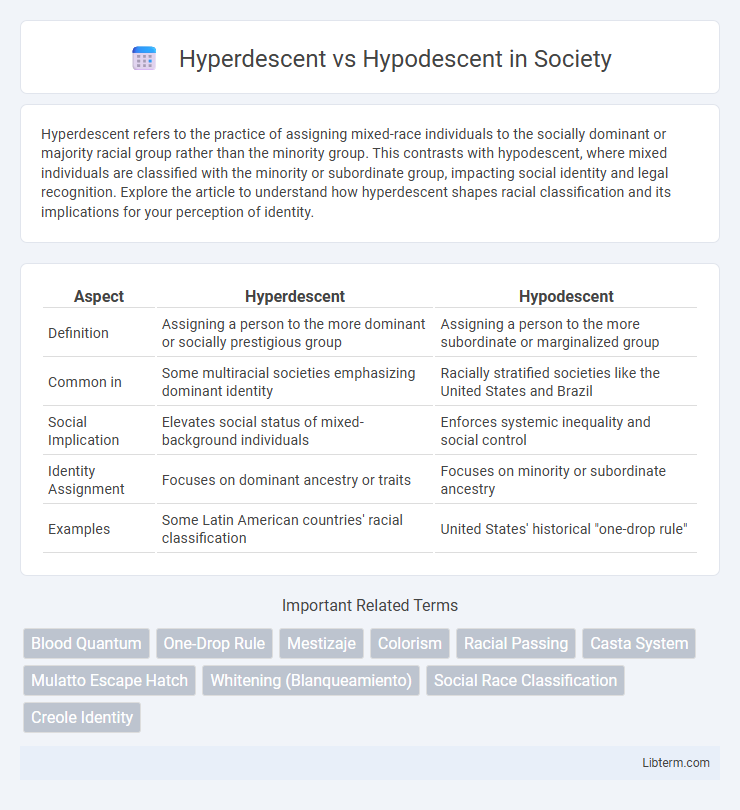Hyperdescent refers to the practice of assigning mixed-race individuals to the socially dominant or majority racial group rather than the minority group. This contrasts with hypodescent, where mixed individuals are classified with the minority or subordinate group, impacting social identity and legal recognition. Explore the article to understand how hyperdescent shapes racial classification and its implications for your perception of identity.
Table of Comparison
| Aspect | Hyperdescent | Hypodescent |
|---|---|---|
| Definition | Assigning a person to the more dominant or socially prestigious group | Assigning a person to the more subordinate or marginalized group |
| Common in | Some multiracial societies emphasizing dominant identity | Racially stratified societies like the United States and Brazil |
| Social Implication | Elevates social status of mixed-background individuals | Enforces systemic inequality and social control |
| Identity Assignment | Focuses on dominant ancestry or traits | Focuses on minority or subordinate ancestry |
| Examples | Some Latin American countries' racial classification | United States' historical "one-drop rule" |
Introduction to Descent Systems
Hyperdescent and hypodescent are two contrasting descent systems used to determine an individual's social or ethnic classification based on ancestry. Hyperdescent assigns identity according to the parent or ancestor with the higher social status or dominant race, while hypodescent assigns identity to the group with the lower status or minority race, often referred to as the "one-drop rule." These descent systems influence social hierarchy, identity formation, and legal classification in multicultural societies.
Defining Hyperdescent and Hypodescent
Hyperdescent defines an individual's racial or ethnic identity by attributing ancestry or traits from a group with higher social status, often emphasizing heritage linked to privilege or power. Hypodescent assigns identity based on the descent from a group with lower social status, traditionally categorizing mixed-race individuals under the subordinate group to maintain social hierarchies. These concepts impact racial classification systems and influence social perceptions and legal definitions of identity.
Historical Context of Racial Classification
Hyperdescent and hypodescent are racial classification systems with deep historical roots. Hypodescent, often called the "one-drop rule," historically assigned individuals with mixed ancestry to the socially subordinate racial group, particularly in the United States during slavery and segregation. Hyperdescent, less common, aligns individuals with the socially dominant or higher-status racial group, reflecting different societal power dynamics and colonial legacies globally.
Hyperdescent: Concept and Applications
Hyperdescent refers to the social practice of classifying a person's race or ethnicity based on the identity of their higher-status or dominant parent, often leading to an upward assignment in social hierarchy. This concept contrasts with hypodescent, which assigns mixed-race individuals to the subordinate group, commonly known as the "one-drop rule" in the United States. Hyperdescent finds applications in societies aiming to promote integration and upward social mobility by affiliating mixed individuals with dominant cultural identities, such as in some Latin American countries where mestizo identity is emphasized.
Hypodescent: Origins and Practice
Hypodescent, historically rooted in colonial and racist legal frameworks, assigns mixed-race individuals to the socially subordinate group, typically the minority or marginalized race, reinforcing systemic racial hierarchies. This practice originated in U.S. laws like the "one-drop rule," which classified anyone with any African ancestry as Black, solidifying social boundaries and perpetuating discrimination. Hypodescent continues to influence identity categorization, impacting social, political, and legal experiences of multiracial individuals.
Comparative Analysis: Hyperdescent vs. Hypodescent
Hyperdescent and hypodescent are contrasting social classifications used to determine racial or ethnic identity based on parentage. Hyperdescent assigns a child's identity to the socially dominant or higher-status parent, whereas hypodescent, often referred to as the "one-drop rule," classifies individuals with mixed ancestry into the socially subordinate group. Comparative analysis reveals that hyperdescent promotes social mobility within stratified societies by elevating mixed heritage individuals, while hypodescent reinforces racial boundaries and social hierarchies by maintaining minority status for mixed-race descendants.
Global Examples of Descent Rules
Hyperdescent and hypodescent are social classification rules that determine racial or ethnic identity based on ancestry. Hyperdescent, seen in countries like Brazil and the Philippines, assigns a mixed individual's identity to the higher-status or dominant group, reflecting social stratification and cultural assimilation. Hypodescent, common in the United States and South Africa during apartheid, designates mixed individuals to the subordinate or minority group, reinforcing racial hierarchies and segregation policies.
Impact on Identity and Social Structure
Hyperdescent and hypodescent shape social identity by determining racial classification through either the dominant or subordinate group's lineage, influencing individual self-perception and community belonging. Hypodescent, often called the "one-drop rule," historically reinforced racial hierarchies by assigning mixed-race individuals to the minority group, affecting social stratification and access to resources. Hyperdescent promotes the affiliation with the dominant group, potentially facilitating social mobility but also complicating racial identity and group solidarity within multicultural societies.
Contemporary Debates and Shifting Paradigms
Contemporary debates around hyperdescent and hypodescent highlight shifting paradigms in racial identity classification, where hyperdescent assigns mixed-race individuals to a higher-status group while hypodescent defaults them to a lower-status group. Scholars emphasize the impact of sociopolitical contexts on these practices, noting that hyperdescent gains prominence in multicultural societies promoting positive racial identities. Research increasingly critiques hypodescent for perpetuating systemic inequalities and calls for frameworks recognizing fluid, self-identified racial affiliations in diverse populations.
Conclusion: Future of Racial Classification Systems
Hyperdescent and hypodescent represent contrasting approaches to racial classification, with hyperdescent assigning mixed-race individuals to a higher-status group and hypodescent classifying them into the subordinate group. The persistence of these systems highlights the complexity of racial identity and the social power structures embedded in classification practices. Future racial classification systems are likely to evolve towards more inclusive, nuanced frameworks that recognize the fluidity of identity and challenge rigid, hierarchical categorizations.
Hyperdescent Infographic

 libterm.com
libterm.com